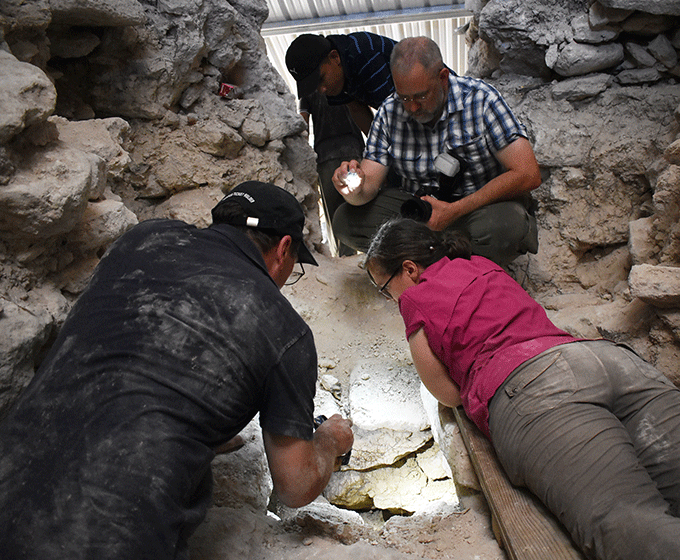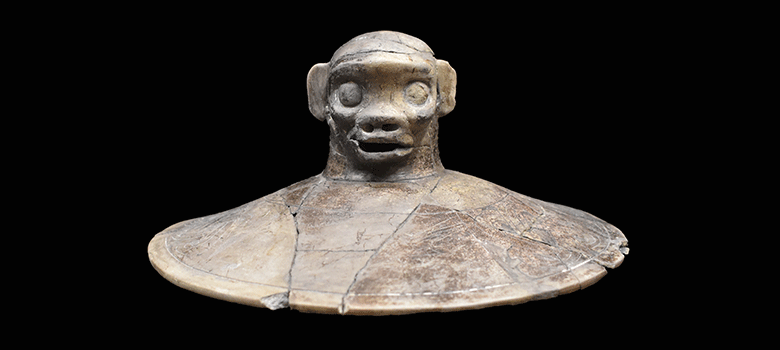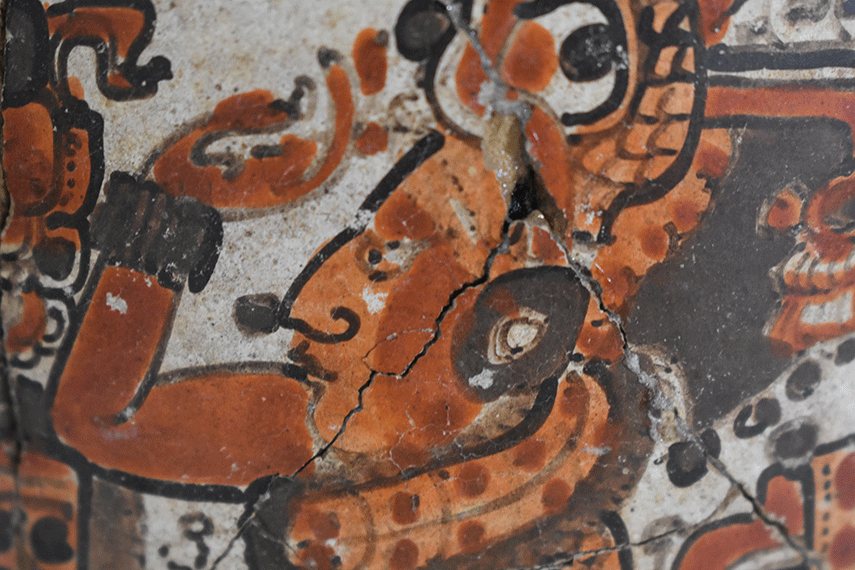
UTSA archaeologists recovered Maya artworks from a royal tomb in Belize that was narrowly missed by looters. The artifacts are being publicly displayed for the first time at the San Antonio Museum of Art.
JULY 14, 2021 — Nature, Power, and Maya Royals, an exhibition of 34 artworks and objects discovered by UTSA researchers in two royal Maya burials at the ancient city of Buenavista del Cayo, Belize, is now on view at the San Antonio Museum of Art (SAMA). This exhibition is the first time the selection of works will appear for public viewing. This exhibition is an exciting collaboration between UTSA, SAMA, and the Belize Institute of Archaeology.
Finely painted ceramic vessels that display kings and symbols of authority, as well as shell pendants, earrings, and bracelets worn by a king, were found in 2014 and 2019 by a team of UTSA archaeologists and led by Lutcher Brown Endowed Professor Kathryn Brown and Jason Yaeger, President’s Endowed Professor of Anthropology at UTSA and senior associate dean of the College of Liberal and Fine Arts.
“The objects in the exhibition are priceless to us and to the government of Belize for what they tell us about the ancient Maya,” Yaeger said. “This show presents a wonderful opportunity to grow connections with institutions across San Antonio and Belize.”

This lid with a monkey-shaped handle dates back to 450 A.D. It was recovered by UTSA archaeologists in a Maya royal tomb in Belize and is being displayed in Nature, Power, and Maya Royals at the San Antonio Museum of Art.
The discovery is particularly extraordinary because looters had previously trenched the building in which one of the royal burials was located, missing it by just a few inches. Finding the site and objects following the looters’ destructive actions is incredibly lucky and makes the discovery particularly special.
“We are delighted to share these beautiful and precious artworks,” said Bernadette Cap, Andrew W. Mellon Curatorial Postdoctoral Fellow at SAMA and curator of the exhibition. “Visitors will also be able to view images taken during our excavation in Belize. The recovery of the objects such as these from known, well-documented locations provide essential information for interpreting similar Maya art held by museums.”

The artworks date between 450 and 800 A.D., a period when Maya kings and queens reigned over large populations and lived in elaborately designed cities. The exhibition highlights how two Maya rulers commissioned artwork that featured commanding iconography to express and legitimate their power. For example, a common theme in rulers’ art was the portrayal of jaguar pelts worn as clothing and used as decorative elements of royal palaces. The Maya admired the jaguar for its strength and skills as an apex predator, and rulers retained exclusive rights over jaguar imagery and products.
One of the most outstanding pieces in the exhibition is a large, elaborately carved pendant made of marine shell. Incised Maya glyphs appear on it and have been deciphered to read, “This is the pendant of Naah Uti’ K’ab, king of Komkom.” The discovery of the pendant confirms that the buried individual is a king. Given the context of recovery, Komkom is likely the original name of the site now called Buenavista del Cayo. Maya texts at nearby sites state that Komkom had been attacked and conquered in the 600s and 700s. The shell pendant dates to around 450, however, and thus provides the earliest reference to the site of Komkom.
Each summer, the UTSA Department of Anthropology brings approximately 10 undergraduates and eight graduate students to Belize to gain valuable, first-hand experience in archaeological research and collect information for their theses and dissertations.
Nature, Power, and Maya Royals: Recent Discoveries from the Site of Buenavista del Cayo, Belize will be on view through February 27, 2022. It was organized by the San Antonio Museum of Art in collaboration with the Belize National Institute of Culture and History’s Institute of Archaeology and scholars in the UTSA Department of Anthropology. It is supported by the Gloria Galt Endowment Fund, Andrew W. Mellon Foundation, and UTSA Maya Archaeology Excellence Endowment. The UTSA excavations that recovered the objects were conducted with the permission of the Belize Institute of Archaeology and funding from the Alphawood Foundation and Termini Endowment for Maya Archaeology.
UTSA Today is produced by University Communications and Marketing, the official news source of The University of Texas at San Antonio. Send your feedback to news@utsa.edu. Keep up-to-date on UTSA news by visiting UTSA Today. Connect with UTSA online at Facebook, Twitter, Youtube and Instagram.
Move In To COLFA is strongly recommended for new students in COLFA. It gives you the chance to learn about the Student Success Center, campus resources and meet new friends!
Academic Classroom: Lecture Hall (MH 2.01.10,) McKinney Humanities BldgWe invite you to join us for Birds Up! Downtown, an exciting welcome back event designed to connect students with the different departments at the Downtown Campus. Students will have the opportunity to learn about some of the departments on campus, gain access to different resources, and collect some giveaways!
Bill Miller PlazaJoin us for an intimate evening of cocktails, conversation, and culinary inspiration with Pati Jinich, Emmy-nominated chef and James Beard Award-winning author. Enjoy light bites and signature drinks in the warm, modern setting of Mezquite as Pati connects with guests over her passion for Mexican cuisine and storytelling.
Mezquite Restaurant in Pullman Market, 221 Newell Ave., San Antonio 78215From inspired courses to thoughtful pairings and a rich sense of community, the Ven a Comer Signature Dinner is a night of shared meals, shared stories, and unforgettable flavor.
Stable Hall (Pear Brewery), 307 Pearl Pkwy, San Antonio 78215Come and celebrate this year's homecoming at the Downtown Campus with food, games, giveaways, music, and more. We look forward to seeing your Roadrunner Spirit!
Bill Miller PlazaThe University of Texas at San Antonio is dedicated to the advancement of knowledge through research and discovery, teaching and learning, community engagement and public service. As an institution of access and excellence, UTSA embraces multicultural traditions and serves as a center for intellectual and creative resources as well as a catalyst for socioeconomic development and the commercialization of intellectual property - for Texas, the nation and the world.
To be a premier public research university, providing access to educational excellence and preparing citizen leaders for the global environment.
We encourage an environment of dialogue and discovery, where integrity, excellence, respect, collaboration and innovation are fostered.